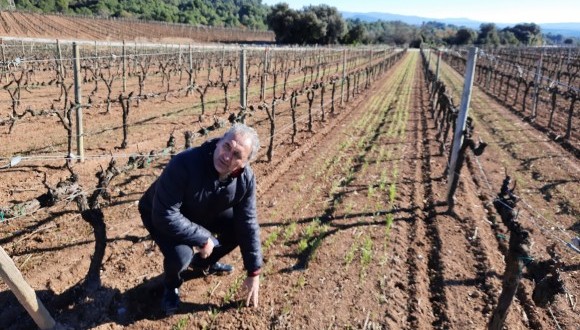Jean Leon and CREAF cooperate on a study of carbon sequestration in vineyards
The test underway will reveal how much atmospheric carbon dioxide soil absorbs with different types of cover crops. CREAF researcher Jordi Sardans is coordinating the study.
At CREAF we are working together with the wineries Jean Leon –from the international wine the brand Familia Torres– to gauge vineyard soil’s potential for absorbing atmospheric carbon dioxide (CO2) and contributing to curbing the climate crisis. By carrying out a three-year study of carbon sequestration at a Jean Leon organic vineyard in the region of Penedès in Catalonia (Spain), we aim to establish which types of cover crops enable soil to store the greatest quantity of carbon.
The project began this winter with the sowing of seeds of four different species of grasses and legumes around vines and between rows of them on half a hectare of land. CREAF’s role is to perform the sampling and analyses necessary to determine how much carbon is present in the soil before and after cover crops are sown each year. Jean Leon, meanwhile, is to carry out the agricultural work involved in sowing and vineyard management.
Carbon farming, a range of farming practices whose efficacy is scientifically proven, is an extremely promising means of reducing levels of atmospheric CO2.
“Using vineyard soil to accumulate CO2 is a great opportunity to reduce the concentration of the gas in the atmosphere,” says JORDI SARDANS, the CREAF researcher coordinating the study. “Furthermore, this solution is not limited to viticulture; it can be applied to any kind of crop and it improves soil quality too,” he continues.

“In addition to our organic viticulture at Jean Leon, all the Familia Torres wineries are working to cut the CO2 emissions our activity generates,” remarks Mireia Torres, general manager of Jean Leon. “We also want to contribute to reducing concentrations of CO2 from anthropogenic sources effectively by sequestering carbon and placing it in stable soil structures.”
The study is in synergy with Coppereplace, a European Interreg Sudoe Programme project in which Jean Leon and Familia Torres are working with the University of Lleida to test cover crops and plant-based mulches, as well as to experiment with alternatives to copper, with the ultimate aim of promoting sustainability and biodiversity.
Carbon farming: key to cutting atmospheric CO2 levels
Various studies have shown that cropland soil could be used for the purpose of accumulating atmospheric CO2 in the ground organically, so as to help slow increases in levels of the gas and, consequently, mitigate climate change. Scientists calculate that Earth’s soil currently contains three times as much carbon as all the planet’s vegetation, and twice as much as is present in the atmosphere.
Carbon farming is an extremely promising means of reducing levels of atmospheric CO2. It encompasses a range of farming practices whose efficacy is scientifically proven, not only in terms of increasing carbon sequestration in soil and the perennial structures of crops, but also as regards improving soil structure, biodiversity and water retention capacity, among other things.

In the specific case of vineyards, the main practices through which carbon is sequestered are the application of organic compost, the use of plants (whether sown or self-seeded) as ground cover, and the incorporation of winter and green pruning litter into soil.






